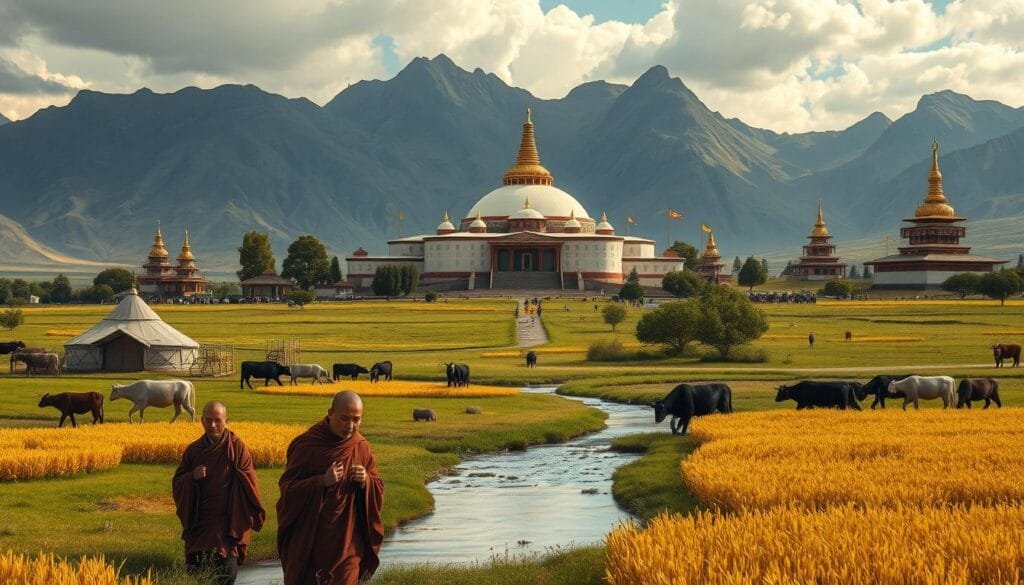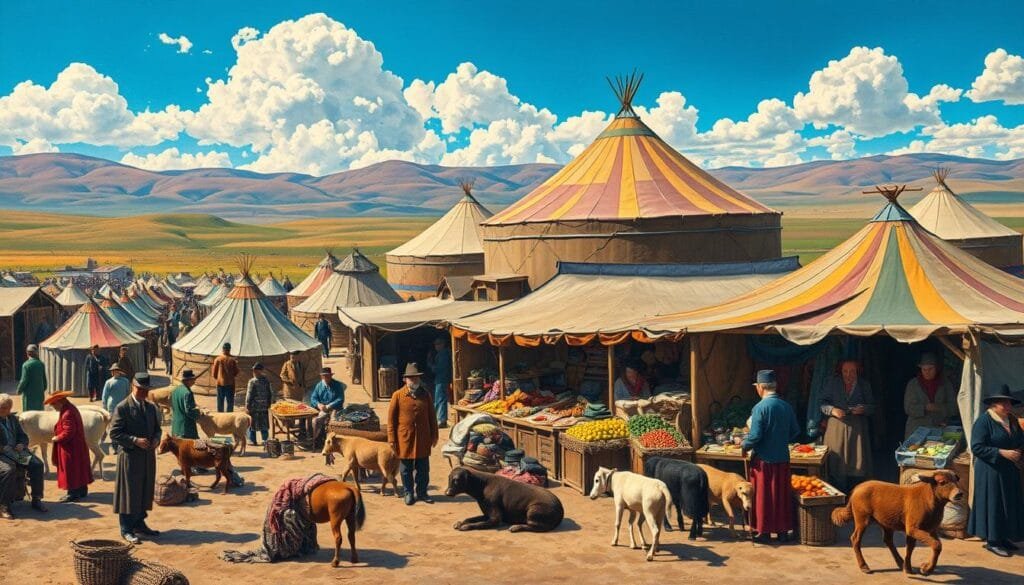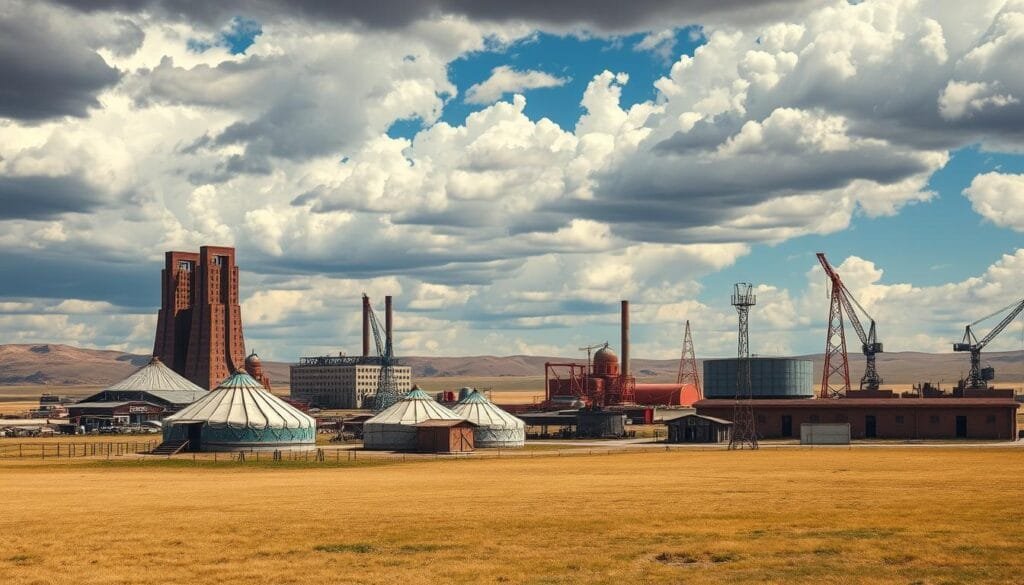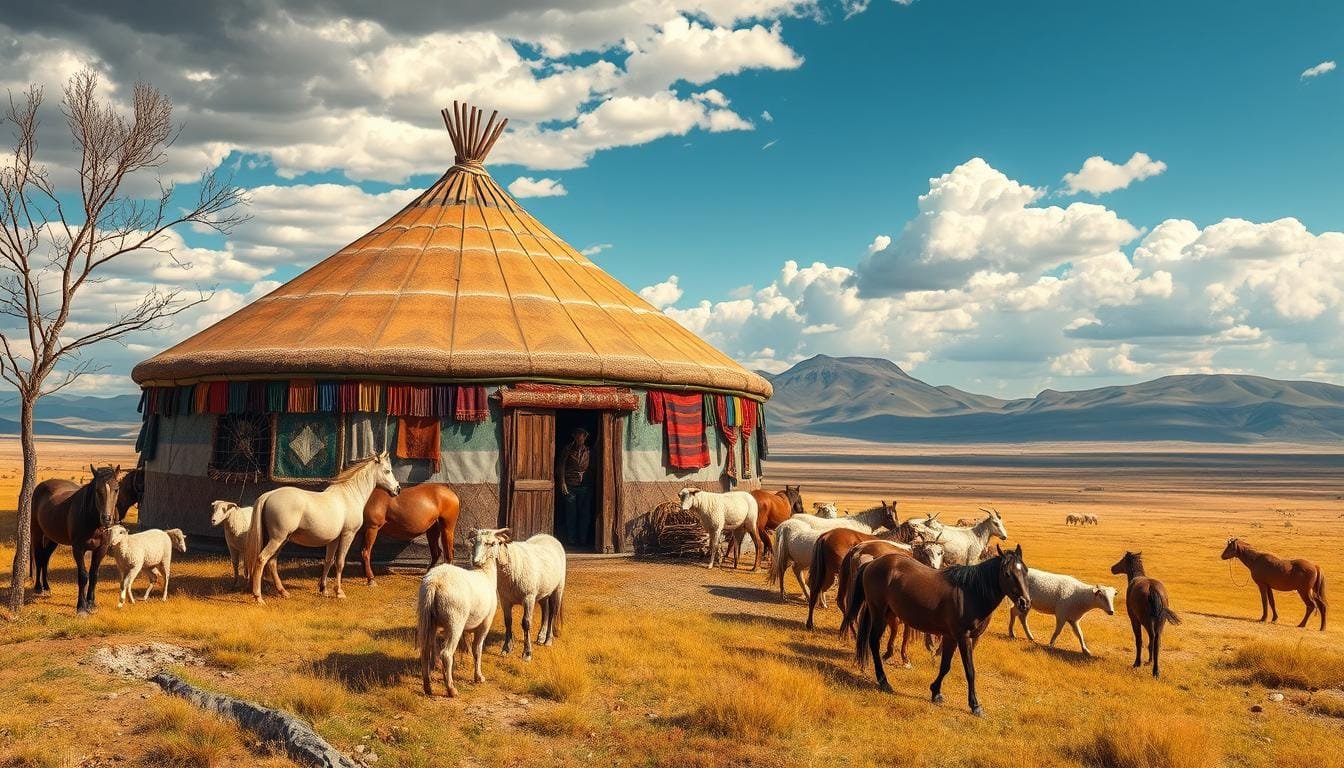How did a group known for their conquests build a rich empire? It starts with the Mongol’s economic beliefs and strategies. As nomads, their way of life stressed the importance of livestock and herding. This foundation was crucial for both their daily life and empire-building under Genghis Khan.
The Mongol empire’s economy was robust, thanks to their smart and flexible wealth and trade methods. For instance, in 1262, they stopped nomads’ animals from entering farmlands. This protected the farmers’ economy. Their approach to managing the economy was both advanced and down-to-earth.
Key Takeaways
- The Mongol economic history is marked by a strategic integration of nomadic and settled practices, creating a resilient and adaptable economy.
- Key decisions, like prohibiting livestock in farmland, reflect their commitment to balancing nomadic and agricultural communities.
- The Mongolian traditional economics prioritized livestock and herding as essential for both sustenance and economic expansion.
- Under Genghis Khan, the Mongol empire’s economy was not just about conquest but also about establishing robust trade networks and wealth management systems.
- The transition from traditional practices to a market-oriented economy post-Soviet era posed significant challenges.
- Today, Mongolia’s economy is characterized by a blend of traditional nomadic practices and modern industrial commerce.
- The Pax Mongolica period witnessed a flourish in trade and economic prosperity, which had long-lasting impacts on global commerce.
The Foundations of Mongol Economic Beliefs
The Mongols developed their economic ideas from their nomadic life and focus on livestock. Over centuries, they adapted to survive and stabilize their economy. Their practical approach built a strong survival system.
Role of Nomadic Lifestyle
Mobility was crucial for the Mongols, not just a choice. Their seasonal migrations ensured herds found fresh pastures. This constant movement was essential for making the most of limited resources.
Their travels also boosted trade with other cultures. This wasn’t just about goods. It included sharing knowledge and cultural insights. Seasonal routes helped them use their surroundings well while caring for nature.
Importance of Livestock
Livestock breeding was key to their survival. The ‘five snouts’ – cattle, goats, sheep, horses, and camels, were central to daily life. These animals provided food, clothes, and items for trade.
Table showing the economic importance of livestock in Mongol culture:
| Livestock | Economic Value |
|---|---|
| Cattle | Source of meat, milk, hides, and dung for fuel. |
| Goats | Provided milk, meat, and fiber for textiles. |
| Sheep | Valued for wool, meat, and milk. |
| Horses | Essential for transportation, warfare, and trade. |
| Camels | Vital for long-distance travel and carrying heavy loads. |
Livestock was woven into their way of life, showing the Mongols’ smart and lasting economic beliefs. They managed to prosper in the tough Eurasian steppes.
Mongol Empire’s Wealth Management
The economic power of the Mongol Empire grew through smart management and protection policies. Genghis Khan led the empire, creating a strong economic system. This system relied on controlling vast trade networks and using advanced economic plans.
Silk Road Trade
The Silk Road was key to the empire’s economy from 1207 to 1368. It helped with trade and connected cultures across Asia and Europe. The Mongols made the Silk Road safe, helping goods to move freely. This greatly helped the empire profit from these trade routes.
Merchant Protection Policies
Genghis Khan’s policies made trading safe and welcoming for merchants. These policies lowered the risks of trading across the empire’s long trade routes. By doing this, the Mongols increased trade and economic activity.
Economic Impact of Genghis Khan
Genghis Khan’s reforms significantly helped the economy. He introduced a standardized monetary system and boosted trade on the Silk Road. His policies improved the empire’s economic health and wealth. His actions also set a foundation for lasting trade success in the Mongol Empire.
The Influence of the Lamaist Church on Mongol Economics
The Lamaist Church economic influence on Mongolia was big, especially after the empire fell. Mongolians didn’t switch to Buddhism quickly. It took centuries. From 1206 to 1210, Genghis Khan’s battles introduced Buddhist ways into their culture.
Buddhism really took hold in the 13th and 14th centuries under Kublai Khan. Monasteries turned into big economic spots, not having to pay taxes. This changed how resources were shared. At this time, Buddhist monks also started to run schools and hospitals.

The Lamaist Church didn’t just affect religion; it also touched governance and everyday life. When William of Rubruk visited from 1253 to 1255, it showed the church’s growing power. During Mönkh Khan’s time, there were big talks about whether monasteries should be taxed.
Now, over half of Mongolia practices Buddhism, according to the 2020 census. This shift started during the Yuan dynasty and continued into the Qing dynasty. The Qing leaders gave a lot of support to Tibetan Buddhism for peace. This helped the Lamaist Church economic influence grow even more.
Today, Lamaism still shapes Mongolia. Viharas built after the 16th century show the church’s big role in the country’s economy and society.
Transition to a Market-Oriented Economy: 1921–1928
From 1921 to 1928, Mongolia began to change its economy. It moved from a traditional herding lifestyle to a market-based system. This change was influenced by the Soviet Union. It became a key part of Mongolian economic history.

In 1921, Mongolia’s new government started to adopt socialist ideas. These ideas helped create a system where the government planned the economy. By 1924, Mongolia became a People’s Republic. This move led the country toward a planned economy and began collectivizing farms.
By the end of the 1920s, over 80% of grazing lands were owned by the state. Also, the government controlled almost 60% of the animals. This was a big change in economic reforms 1920s Mongolia.
During this time, many people moved to cities. For example, Ulaanbaatar’s population grew by 20% from 1924 to 1928. People left rural areas to live and work in urban places.
This urban shift also brought changes in education. Literacy rates went up by 50%. The government wanted everyone to learn skills for new jobs.
| Year | Major Changes |
|---|---|
| 1921-1924 | Revolutionary government, focus on socialist policies, influence of Soviet Union |
| 1924 | Declaration of Mongolian People’s Republic, introduction of planned economy model |
| 1925-1928 | Collectivization of agriculture, urbanization, and educational reforms |
Industrial output in Mongolia jumped by nearly 30% annually. This increase was seen mostly in mines and heavy industry. Yet, this growth faced obstacles.
The country’s overall economy went down by about 15% from 1924 to 1928. Forced collectivization hurt traditional ways of making a living.
By 1928, the state owned more than 90% of businesses. This made Mongolia rely a lot on the Soviet Union. About 70% of its trade was with the Soviet Union. These economic reforms 1920s Mongolia shaped Mongolian economic history for years to come.
Soviet Era Economic Policies and Their Effects
The Soviet era was a big change for Mongolia, especially in its economy. It started using centralized planning, creating lots of state businesses. This changed things a lot. It helped Mongolia grow but also brought problems, mainly for nomads living in rural areas.

Development of State-Owned Enterprises
Mongolia got many state-owned companies under the Soviets. This time focused on making more factories and central economic control. Big industries like mining got lots of attention. This made the industrial part of the economy bigger.
Another big change was focusing on huge industrial projects. State businesses became very important, changing Mongolia’s economy. This brought development but also made Mongolia depend on these plans.
| Sector | Contribution to GDP (2017 Estimate) |
|---|---|
| Agriculture | 12.1% |
| Industry | 38.2% |
| Services | 49.7% |
Challenges Faced By Rural Nomads
Industrial growth and more control by the state changed things for rural areas. Nomads found it hard to fit into the new system. They had a tough time as their traditional ways didn’t match the economy’s changes.
Nomads faced big problems like no jobs and doing worse in farming. The economy didn’t really help them, making life harder in rural Mongolia. This happened during and after the Soviet influence.
Mixing industrial growth with traditional ways is a big part of Mongolia’s story. The Soviet policies had a lasting effect. They still shape how Mongolia’s economy works today.
What was the belief of the Monguls about economics
Mongol economic beliefs focused on being adaptable and sustainable. Their economic practices came from traditional Mongolian ways. They developed economic strategies that fit both their mobile lives and their huge empire.
The Mongols made sure different ways of life worked together in their empire. They gave tax breaks and stored extra grain to help farmers in North China. This helped keep the farming economy strong and ensured food was available when needed.
They also set up rules to protect farmers’ fields from nomads’ animals in 1262. This shows how they balanced the needs of nomadic and farming communities.
The Mongols planned ahead in building infrastructure. They extended the Grand Canal to Daidu and set up a postal system. Even though these projects made the peasants work hard, they were key for trade and connection across the empire.
| Key Economic Practices | Examples |
|---|---|
| Tax Support | Fixed taxation structure for peasants, tax remissions |
| Infrastructure Investment | Grand Canal extension, postal-station system |
| Agricultural Protection | Prohibition of roaming animals in farmlands |
| Livestock Management | 15-year period of favorable grazing conditions |
| Adaptation to Societal Changes | Formation of rural cooperatives |
Mongolian traditions included forming rural cooperatives. These groups of about 50 households helped increase agricultural production. They would count how many people and how much food they had, showing Mongols cared about community economics.
Mongols also planned for environmental changes. They had a period of good weather that helped their animals and their way of life. This flexibility helped them control vast and different lands.
Mongol economic beliefs blended their nomadic ways with smart strategies, creating a strong system. This system helped both countryside and city areas thrive. Their economic methods helped the Mongol Empire become a major power in Eurasia.
Conclusion
We can learn a lot about resilience and creativity from the Mongol economic system. It changed a lot over the years. The Mongol Empire, started by Genghis Khan in 1206, became the biggest connected land empire ever. It spread across 9 million square miles.
This huge empire brought different cultures, economies, and trading ways together. The Silk Road was super important for connecting the East and West. The Mongols made trade easier by improving routes, setting up a common currency, and a universal tax system. They also built roads, bridges, and post stations to help trade.
The Mongols did more than just conquer. They had laws to protect traders and invested in farming technology. They were also open to different religions. Khubilai Khan even had policies to help farmers when crops failed. These actions showed the Mongols were thinking ahead. They made their economy better.
These smart moves help us understand Mongol economy today. To get a deeper look into Mongol economics, check out this detailed summary of Mongol economics. It dives into their historical economic strategies and their long-lasting effects.
FAQ
What were the fundamental economic beliefs of the Mongols?
Mongol economic beliefs were based on their nomadic life. They valued livestock breeding and being able to move freely. Their way of living provided them with clothes, food, and items for trading.
How did livestock play a role in Mongol economic strategies?
Livestock were key to the Mongols’ economy. Cattle, goats, sheep, horses, and camels, known as the ‘five snouts,’ were crucial. They supplied food, clothes, and trade goods, driving their economic success.
How did the Silk Road trade impact the Mongol Empire’s economy?
The Silk Road trade boosted the Mongol Empire’s economy greatly. It allowed the exchange of goods, ideas, and culture between Asia and Europe. This network led to prosperity and cultural connections.
What were the economic policies implemented by Genghis Khan to protect merchants?
Genghis Khan protected merchants with specific policies. He provided them with protection and incentives. These actions helped trade flourish, making the empire richer and more powerful.
How did the Lamaist Church influence Mongolia’s economy?
The Lamaist Church deeply influenced Mongolia’s economy. It managed education and healthcare services and didn’t pay taxes. Its role affected Mongolia’s economic and social structures during its feudal period.
What structural reforms did Mongolia undergo between 1921 and 1928 to transition to a market-oriented economy?
From 1921 to 1928, Mongolia changed its economy. It set up a national bank and its own currency. It encouraged private and international trade. It modernized with Soviet Union’s help.
What challenges did rural nomads face during the Soviet era economic policies?
Rural nomads struggled because of the Soviet focus on state-owned businesses. These policies clashed with their way of life, bringing socio-economic challenges.
How did the Mongol economic beliefs adapt to their environmental context?
Mongol economic beliefs adapted to their surroundings. They focused on herding, trading, and adapting to change. This ensured they thrived amidst political, social, and cultural shifts.
